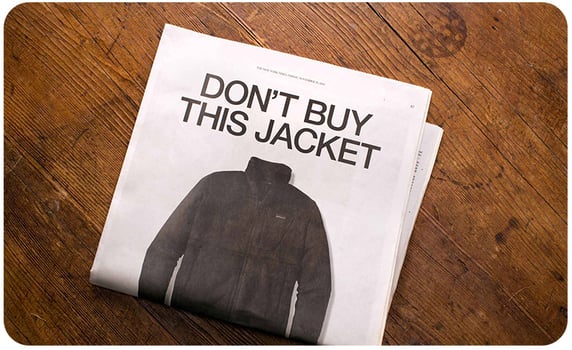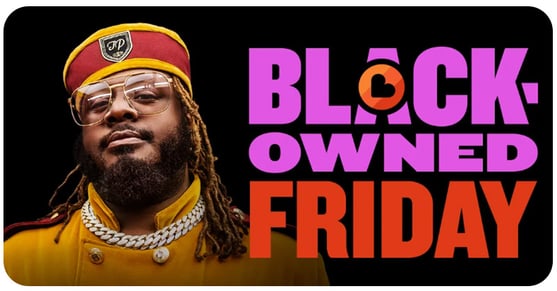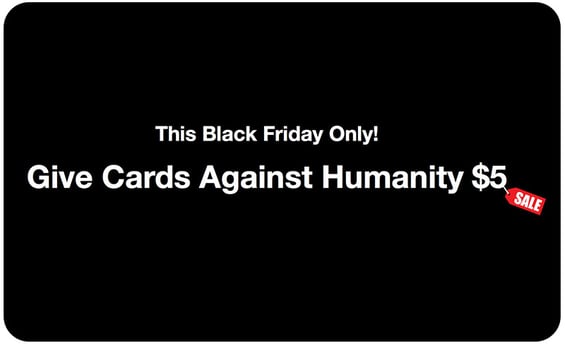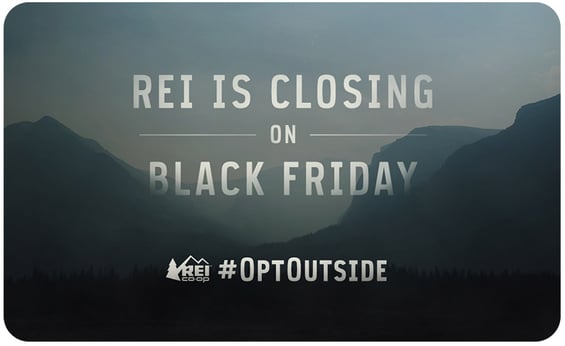Brands vs consumerism: Black Friday campaigns that changed the retail game

Posted by Nadia Reckmann
November 23rd, 2023
It’s your regular Thursday night, the time is 23:59. The promise of winter is hanging in the increasingly chilly air. It’s quiet but for the sound of an occasional stray car.
The clock strikes midnight, and everything changes.
Deal hunters and shop owners across the world twitch in their restless sleep, instinctively knowing that the most important day of the year is upon them. Black Friday has entered the metaphorical building.
At least, that’s how it used to be.
While this bargain-driven day has been historically linked to a shopping frenzy—rivalled only by the Toilet Paper Panic of 2020—in recent years, the attitude of both shoppers and brands towards Black Friday has noticeably changed.
Consumers no longer need to camp by the doors of their favourite shops overnight and, instead, can snag the best deals online. At the same time, retailers can maximise their profits by extending the discount period outside of a single day. What’s more, shoppers have become increasingly socially and environmentally conscious, expecting the same from the brands. In fact, many of them feel that brands bear as much responsibility as governments in driving positive change.
In this blog post, we will dissect the most remarkable Black Friday campaigns that changed the consumerism game by shifting the spotlight to the topics and initiatives that align with their brand values and resonate with the modern consumer.
#1 The most profitable anti-sales campaign

Ever since its inception, Patagonia has been an embodiment of social and environmental awareness. Unlike many brands that settle for greenwashing, Patagonia has embedded eco-friendliness into its core values and has remained true to them over the years. Their ‘Don’t Buy This Jacket’ Black Friday campaign was a perfect example...that brought unexpected financial returns.
What’s it about?
In 2011, Patagonia published a full-page Black Friday ad in the New York Times, featuring an image of one of their jackets and advocating for readers not to buy it. Under the photo, the company listed the reasons for their appeal, including the 135 litres of water required for the jacket’s production (enough to meet the daily needs of 45 people), the 20 pounds of carbon dioxide generated due to shipping, and the fact that it left two-thirds of its weight in waste.
Results
Despite the communicated message, the campaign resulted in a 30% increase in sales for the company. While on the surface, this might seem like an unexpected and fortunate result of customers rewarding the brand for its selflessness, when examined more closely, the ad reveals to be an example of clever and subtle marketing.
While Patagonia advocates for reduced consumption, the ad subtly describes the jacket in question as top-selling and casually mentions that it’s made of 60% recycled polyester, knit and sewn to a high standard, and is exceptionally durable. It then proceeds to ask readers not to buy what they don’t need. Unsurprisingly, that is exactly when they realise just how much they need it.
To their credit, Patagonia did commit to contributing 100% of its future Black Friday profits to global environmental NGOs. Needless to say, a gesture like that wouldn’t have gone unnoticed by their customers.
Takeaways
Determine your brand values and stay true to them. If you decide to include environmental consciousness among them, make sure to deliver on your promises and go beyond simple box-ticking. Customers value authenticity—and are happy to reward you for it. Being smart with your content marketing doesn’t hurt, either.
#2 From Black to Black-Owned

If anyone has the drive and resources to turn an ultra-commercial holiday into a social movement, it’s Google. When it came to Black Friday, rather than trying to change the nature of the day completely, the tech giant pivoted to promote Black-owned businesses. Considering that out of the 5.7 million U.S. businesses with 2+ employees, only 2.3% are Black-owned, the initiative was hitting just the right notes.
What’s it about?
Kicked off in 2020 in tandem with the U.S. Black Chambers, over the past years, Google’s Black-Owned Friday featured music videos from Wyclef Jean, Ari Lennox’, T-Pain, Normani and Flo Milli, all encouraging shoppers to buy from Black-owned businesses. This year, Keke Palmer launched a devilishly catchy remix of the Crystal Waters classic ‘100% Pure Love’, coming with its own mini-site, featuring the actual business owners and even allowing viewers to buy Black-owned products that appeared in the video.
Results
While the Black-Owned Friday campaign is remarkable in its own right, it works particularly well with (and is directly linked to) Google’s search engine feature that allows users to look up Black-owned businesses. Considering that, according to McKinsey research, one in five customers cited not finding the products they wanted as the main reason for not buying from Black-owned businesses, making that search easier benefits both the customers and the tech giant.
Takeaways
If you decide to launch a socially relevant campaign, make sure that it’s directly linked to your products or services. This way, you will enhance your brand reputation, make a difference and grow revenue, all at once.
#3 The ode to consumerism

In a bold departure from Black Friday norms, sustainable accessory and footwear brand Allbirds sends a powerful message with their campaign, "Break tradition, not the planet." Renowned for its commitment to sustainability, Allbirds took a distinctive stand during the Black Friday shopping season.
While many retailers slash prices for Black Friday and Cyber Monday, Allbirds took a different route—increasing all prices across its entire collection by £1. This unconventional move serves a dual purpose: reinforcing the brand's dedication to sustainability and contributing extra funds to Fridays For Future, the youth-led international climate movement founded by Greta Thunberg.
This innovative approach challenges the consumerism-driven narratives of the season, proving that conscious choices can redefine the holiday shopping experience. Allbirds doesn't just sell products; it sells a commitment to a better, more sustainable world.
Cards Against Humanity (CAH), an adult-tailored card-matching game, has cheek at its very core. The entire brand is built around mocking conventions, so it’s no surprise that their Black Friday campaigns would follow suit. Over the years, CAH asked people to pay them for digging a big hole, sold actual (forgive our French) bull shit, and even paid people for doing bizarre tasks like ordering a burrito that is just sour cream or giving a hot dog to a mail carrier. And all along, they made a shiny profit and reinforced their brand.
But those seemingly random and often crass campaigns are about more than brand-flavoured fun – it's a deliberate and clever stab at consumerism. The company’s co-creator, Max Temkin, has previously described Black Friday as a “repulsive consumerist frenzy right after a day about being thankful for what you have,” so turning its essence into a farce certainly makes sense.
While there are plenty of worthy candidates among their Black Friday initiatives, the 2013 ‘Give us $5’ campaign holds a special place in our hearts.
What’s it about?
In this two-phase campaign, CAH turned the very concept of discount-driven Black Friday upside down and raised their prices instead. To add a signature insult to a consumerism injury, they went ahead and launched a sale of absolutely nothing for $5. The 'Give us $5' deal was labelled as a “once in a lifetime opportunity to give them $5”, with no returns. And before you ask, no, the proceeds didn’t go to support starving kids in Africa or address minority issues. They were simply distributed among the staff. Well, it could be worse.
Results
The first phase, encouraging people to pay $5 more for the same products, resulted in a $71,145 profit. But wait for this. By asking their customers to simply give them money out of the goodness (or cynicism) of their hearts and live streaming the whole thing, the company brought in over $100,000. Based on the comments below their original post, people appreciated their bold move and were happy to be in on the joke.
Takeaways
Know your audience – and their sense of humour. Consider testing your tone and jokes in your communication and small-scale campaigns to finetune it and determine the boundaries. Your customers are more likely to respond positively to your bolder initiatives if you hit the right notes.
#4 From a campaign to a movement

For many companies, especially in the U.S., Black Friday is one of the most profitable days of the year. So, when a brand decides to close its doors and stop all commercial operations in favour of encouraging its customers and employees to go and enjoy life outside of the shopping madness, it’s bound to turn heads.
Founded as a local co-op in 1938, Recreational Equipment, Inc. (REI) is an outdoor gear provider that has put the concept of accessible and affordable exploration at the very core of its brand values. That is why when they first launched the #OptOutside campaign in 2015, it perfectly resonated with their audience and caused just the right amount of stir.
What’s it about?
Ever since 2015, every Black Friday, REI closes the doors of its 150+ U.S. stores, stops processing all online payments, hangs up the phones in its numerous call centres and effectively shuts down the entire business, giving its employees a paid holiday to enjoy the great outdoors. They call it the #OptOutside day.
What started as a brand-driven one-off marketing campaign turned into an annual tradition and an entire movement, driven by the shared hashtag and values.
Results
Closing the stores and stopping processing all payments might seem like a bold and risky business move – and it certainly was. But the eventual rewards were well worth it. In just 24 hours, the 2015 campaign brought in a 7000% increase in social impressions and over 2.7 billion media impressions. The hashtag alone was used 156K times on Twitter and Instagram – by 2019, the number climbed up to 259K, and the engagement skyrocketed 3000% to 11.6 million.
But the impact didn’t stop there. Just a year after the #OptOutside launch, more than 540+ non-profit and commercial companies joined REI in what was shaping up to be a movement. By 2017, more than 700 organisations and 7 million people had followed suit, trading shopping aisles for hiking treks. Today, #OptOutside is not limited to one day a year – it has become a philosophy, with the hashtag used by artists, activists and the general public, trying to shift the consumerism mindset. As for REI, they have become a staple of socially relevant change, accessibility and inclusion, driving unyielding customer loyalty and brand value. Not bad for a mere hashtag and an experimental campaign.
Takeaways
Firstly, remember that your brand values apply to your internal operations just as much as they do to your customer approach and business dealings. By driving the change from within, you’re likely to nurture employee advocacy and increase the impact of your initiatives.
Secondly, not all campaign success can be measured in immediate revenue growth. Social and public recognition can be just as important and lead to long-term customer loyalty, community activation, and brand recognition – all contributing to lasting business success.
Sign up for our newsletter now to stay in the loop. Get the latest insights and trends delivered straight to your inbox - it's the easiest way to stay connected with us! Simply subscribe using the link below.


Previous Post
How digital platforms are refocusing on the user experience
Next Post

5 marketing updates you can’t ignore for a stellar 2024 strategy
Subscribe Here
You may also like...
Nadia Reckmann | Aug 16, 2024
Nadia Reckmann | May 30, 2024
Nicole Thomsen | Dec 11, 2023






